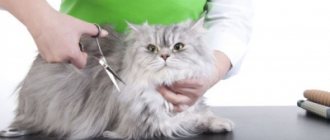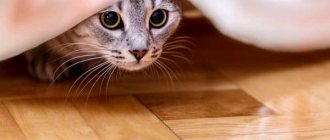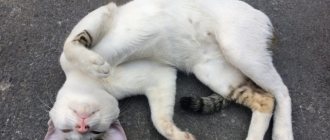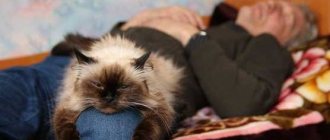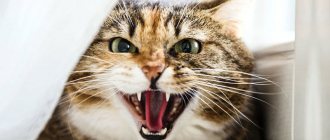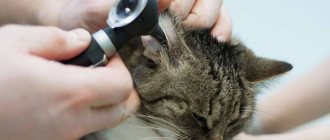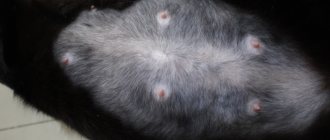The strange behavior of a cat after a haircut has a number of reasons and explanations. No matter how high-quality the procedure is, the animal experiences stress and discomfort during and after it. You should not take your pet to a groomer solely for aesthetic purposes. The main motivation should be to help the cat survive the heat or get rid of a blob of fur. If you do not consistently take care of your pet’s appearance, a number of dermatological problems will overtake it. To better tolerate the adaptation process, there are a number of rules and tips to help the owner.
Cat's reaction after haircut?
A cat may behave strangely after being cut. The following behavioral reactions are typical:
- refusal of food;
- attempts to avoid contact with people;
- desire to hide.
The first visit to the groomer is stressful for an animal, but not a single pet has ever died from it.
A cat's haircut is done for hygienic rather than aesthetic reasons. This helps regulate heat exchange in the hot season and relieve your pet of tangles that tighten the animal’s skin and cause discomfort. If you don't take care of your animal's fur, your pet may develop skin diseases: ulcers, wounds, pimples. After cutting, the hair does not grow back in clumps, but becomes shiny and even.
Reasons for behavior
Cats, when they lose their fur, behave inappropriately, as their owners think. But this is a normal reaction of an animal that has been clipped for the first time. The kitten cannot lie down quietly and wait for it to start being cut; for it, in any case, this is an uncomfortable state. He feels awkward and tries to hide. Over time, with regular visits to the groomer, the pet gets used to the procedure and behaves in the usual way. It is worth paying attention to the professionalism of the specialist. If the animal is frightened by the noise, the groomer himself, due to cruelty in treatment, then the cat may begin to hiss and scratch. If the cat was fluffy and suddenly lost its “fur coat,” it may feel cold and try to warm itself near the radiator, under the blanket. Often she shakes and hides.
Stress and mental disorders
It is rare, but it happens that scratching in cats is associated with a mental disorder. Most often, the wounds resemble scratches, but are not them, since the cat is actively licking itself. Wounds form on the paws and shoulder blades. The size and depth of the wounds is rapidly growing, but despite the pain. the cat continues to lick itself.
Assumptions about neurosis are relevant if all of the above reasons could not be confirmed. The diagnosis is confirmed by prescribing a course of sedatives, if the cat begins to actively lick itself and the wounds begin to dry out - the reason is stress.
Correct haircut
To make the fur reduction procedure on your cat more comfortable, you should immediately bathe the furry cat after cutting it. This is done so that the remaining fur does not prick and cause itching. It is advisable to praise the cat more, pet it, and pay attention to it so that it feels calmer. If the animal begins to shiver from the cold and look for a warm place, it is better to dress it or cover it with a blanket so that the body gets used to the temperature. It is necessary to remove piercing and sharp objects from the cat’s habitat so that the pet does not get hurt by them.
Animals are trimmed for decorative and hygienic purposes. Violation of the rules for caring for furry pets leads to the formation of tangles, which cannot be gotten rid of simply by combing. Stress in a cat after a grooming procedure is a common phenomenon, provoked by strangers, the sound of a running machine, and unusual sensations for the animal.
Diagnosis of scratching and itching
Itching is probably one of the most unpleasant sensations that can only be relieved by scratching. It has been proven that a person can become psychotic if they experience itching and cannot scratch themselves. Itching in an animal is a clear sign of skin damage, although it can occur before obvious symptoms appear. In veterinary medicine, as in human medicine, itching is distinguished depending on its nature:
- Localized – one or more specific places are itchy, for example, scratching appears only on the face or on the neck and cheeks.
- Generalized – when the cat’s entire body itches.
What happens to a cat during a grooming session with a specialist?
Doctors advise carrying out pet grooming procedures at home, and not in a specialized or veterinary clinic. A familiar environment calms the animal and does not cause tension. The statement is relative - the arrival of a stranger, incomprehensible manipulations frighten the furry pet, only the constant support of the owners can reduce the negative impact of stress factors.
When traveling to the salon, the animal is subjected to great overexertion:
- The path from home to the clinic. Extraneous noises have a negative impact on the psyche, especially if the cat is constantly in the apartment and does not walk the streets. Upon arrival, he becomes aggressive or refuses to leave the carrier.
- Meet the master. Not all animals tolerate this procedure well. A stranger is perceived negatively; many pets try to scratch or bite him.
- Trimming claws. This is a must before trimming the coat. If the cat has never encountered it, then the manipulation will provoke aggression or fear towards the specialist.
Why does the animal’s behavior change after the procedure?
Professional grooming does not cause physical harm - the professional acts carefully and as quickly as possible. Most injuries occur when trying to solve a problem on your own. If animals behave strangely after a haircut, this is the first sign of stress. Without the help of the owners, the cat develops and worsens severe depression.
Unusual conditions and unusual actions of a stranger
After a haircut in a salon, some animals begin to hide, avoid the owner’s attention, and demonstrate an aggressive attitude towards family members. The problem is associated with traveling to an unfamiliar place, noise, strangers and other pets. Some experts advise calling a hairdresser to your home - this will reduce the level of tension. The care of the specialist after the procedure will convince the cat that the source of the trouble has disappeared.
Veterinarians recommend carrying out manipulations in clinics or special salons - at home, the animal should feel safe, and not wait for the unpleasant person to return. The decision about where to receive hairdressing services depends only on the owner.
Effect of anesthesia
The influence of medications can reduce discomfort in a cat, but anesthesia itself is a serious test for its body. Sedative medications affect the functioning of the respiratory, cardiovascular and other systems. For this reason, grooming is carried out strictly according to indications, taking into account the individual characteristics of the animal’s body.
Before the procedure, the cat undergoes an examination, the owner is informed about the possible risks - sedation is contraindicated in case of heart disease. Most pets do not need medical assistance: an experienced groomer can easily cope with the manipulation without it.
Anesthesia and haircuts on the first day provoke inappropriate behavior in cats: they lose orientation in space, constantly sleep, or attract attention to themselves with mournful meows. Veterinarians advise avoiding sedation whenever possible to avoid side effects from medications.
Unusual sensations of a cat after a haircut
Changes in the amount and volume of fur can cause non-standard manifestations in animals:
- cats cannot lie down after being trimmed - short hair causes unusual sensations when in contact with any surfaces;
- freezing - a small draft provokes attempts to hide in a blanket, under a blanket or on a shelf with linen;
- refusal to communicate – the unusual appearance irritates the pet;
- hunger strike or continuous consumption of food - refers to manifestations of distress;
- hunting for your own tail.
What is overgrooming in cats?
Overgrooming in cats is a rather poorly studied pathology, characterized by excessive licking of certain areas of the body, as a result of which the hair in these places becomes thinner, and then bald spots are formed - areas of open skin, sometimes with the presence of wounds.
Cat owners need to know that overgrooming often occurs in animals due to psychological reasons.
With this disease, the cat can not only lick, but also bite the skin so that wounds appear. If you do not treat your pet, painful licking can even lead to the amputation of a part of the body.
Cat owners need to know that overgrooming often occurs in animals due to psychological reasons, usually associated with the cat experiencing stress.
Due to the current lack of serious, in-depth research into the causes and treatment of the disease, adjusting the behavior of cats is a long process , in parallel with which the pet’s skin is also treated.
What parts of the body are at risk?
Completely different areas of the body can be overgroomed, but most often cats lick:
- stomach;
- the inside of the hind legs;
- front legs;
- underbelly;
- lateral parts of the body.
Treatment of overgrooming in cats
Important! Only a specialist can cure dangerous licking of a cat’s fur.
The veterinarian, after examination and some research carried out on the basis of tests, can determine the root cause of the disease. If overgrooming occurs as a result of stress, correction of the animal’s behavior is prescribed by a zoopsychologist.
If the disease is caused by an allergy, then after tests and a conversation with the owner, this product is excluded from the animal’s diet. In especially dangerous cases, when the cause of the disease is infection of the cat’s body with parasites, the doctor prescribes antihistamine therapy.
How to reduce unpleasant consequences to a minimum?
To alleviate the stressful state, you need to try to gradually reconcile the animal with the procedures performed. The main method is psychological:
- rid the cat of contact with unpleasant objects - nail clippers, scissors, hair clippers;
- distract with treats, new toys, favorite activities;
- during and after the manipulations, constantly talk and stroke;
- Do not laugh or focus on the appearance of the trimmed cat.
If there are no results from psychological assistance, you should visit a veterinarian and get the necessary medications. The list of possible medications is presented:
- Pheromones - aerosols of synthetic origin. After spraying the substance, animals experience an emotional uplift and a feeling of security and safety.
- Antidepressants - prescribed by a veterinarian when a pet falls into a state of deep depression. Therapy is carried out with Valium, Diazepam.
In addition to medications, the doctor may recommend wearing a special collar soaked in pheromones and a complex of essential oils. It allows the animal to quickly get out of a stressful state and stop constantly licking itself.
Cats do not always react aggressively to hairdresser's manipulations. Indifference to procedures is observed in sterilized animals. Their psyche is more resistant to external stimuli, their behavior is characterized by calmness and pronounced laziness.
Experts point out that changing the appearance of furry pets cannot occur only at the whim of the owner; the procedure requires good reasons. The desire to create a fashionable “hairstyle” can cause a long-term quarrel between the animal and the owner, cause hidden anger in the pet and provoke a long cold war.
Why does the cat shake its tail?
The tail of cats serves primarily as an indicator of mood. By moving it, they express:
- Anxiety. By wagging its tail and pressing its ears to its head, the pet shows that something is bothering it.
- Willingness to engage in combat with a possible enemy or pursue a victim.
- Doubt.
- Pleasure. Cats wag the tip of their tail when they are happy and try to show their owners the depth of their overwhelming feelings.
- Curiosity. When a pet explores something with interest, its tail twitches.
- Irritation. If an animal actively swings its tail from side to side, it means it is irritated.
The cat's tail and skin on its back twitch - why and what does this mean?
Cat owners sometimes observe the following picture: the pet's tail twitches, as if he is marking territory, and the skin on his back shakes, as if he is trembling in this particular part of the body. This phenomenon may have physiological and pathological causes. Regardless of what exactly led to the twitching of the tail and skin, the four-legged pet in this situation requires the help of the owner.
The animal has fleas or other ectoparasites
If an adult cat or kitten twitches its tail, while the skin on its back trembles, it may be overcome by ectoparasites (those that parasitize not under the skin, but on its surface): fleas, lice eaters, ticks. In addition to these symptoms, external parasites manifest themselves as follows:
- bite marks on the body in the form of small red dots;
- unbearable itching in the affected areas;
- constant scratching in an attempt to somehow relieve the itching from the bites;
- jumping black dots, grains that look like dirt;
- deterioration of the coat (loss, loss of shine, fragility);
- sleep disturbance – due to constant itching, the cat hardly sleeps;
- complete or partial lack of appetite;
- anxiety, lack of interest in games, apathy;
- ulceration of the affected skin, scabs;
- reduction in body weight.
The cat is nervous
Is your pet shaking its tail? This may be a sign of anxiety. Don't confuse anxiety with stress. Both of these conditions are associated with negative emotions, but in the first case they are not as pronounced as in the second. Anything can cause anxiety in a cat. She may get nervous because of a large crowd of people in the house, the appearance of a stranger in it, the long absence of the owner, etc.
In order for the pet to calm down, you need to pick it up, caress it, and talk to it. It is best to try to switch the animal's attention to something else, such as a game. By spending time actively and having fun, it will forget about worries.
Pet wants to go to the toilet
If an animal's back twitches closer to its tail, it most likely wants to go to the toilet. Observing cats, you can notice that their skin in this area begins to tremble before bowel movement occurs. This is normal.
This situation requires the intervention of the owner if the trembling does not end with defecation, and the pet becomes restless, meows pitifully, and refuses to eat. This behavior indicates constipation. If your four-legged pet does not defecate for several days in a row, it is time to take measures to empty its intestines of feces.
The cat was bitten by an insect on the back or tail (mosquito, wasp, etc.)
Is your pet twitching its tail, the skin on its back shaking, while it is worried about something or meowing pitifully? Perhaps he was bitten in this place by a wasp, bee, mosquito or horsefly. To help your pet cope with itching and pain, you must first make sure that there is no insect sting left at the site of the bite. If it is detected, you need to carefully remove the foreign body with disinfected tweezers.
Causes of scratching
The first thing the doctor will do is examine the animal for the presence of parasites. Flea scratches appear all over the body, most often on the cheeks, neck, chin and at the base of the tail. In most cases, even if the animal has recently been treated, parasites are the cause of the itching.
The cat itches because the saliva of blood-sucking parasites always causes an allergic reaction. If you have ever been bitten by a flea or tick, you know that the bite itself is not felt, but afterwards it itches a lot. Flea saliva, injected under the skin, acts as a pain reliever, but since it has a protein base, after some time an allergic reaction occurs.
Note! The development of a flea allergy does not always imply the presence of a large number of parasites; for cats with sensitive skin, a few bites are enough for scratching to appear.
The next most popular reason is microscopic mites. Itching from mites is incomparably stronger than allergic; the area affected directly depends on the method of parasitism. For example, when infected with ear mites, a cat scratches the skin near the ear, forehead and back of the head within 24 hours. The subcutaneous mite can settle on the back, body, under the arms or even on the tail. To confirm or refute the diagnosis, a scraping is taken from the damaged skin for laboratory examination.
During laboratory analysis, scrapings are also checked for the presence of spores, which will indicate a fungal infection of the skin. Cats, dogs and people constantly have fungi and microorganisms living on their skin; not all of them are friendly, but the symbiosis is designed so that the bacteria do not attack the host. When the level of immune defense drops or an active, unfriendly culture is introduced, the cat may develop microsporia, which for many is more commonly called lichen.
Statistically, cats are more likely to get ringworm, but are practically not susceptible to other skin ailments. If the diagnosis is confirmed, the veterinarian will prescribe a course of treatment. Typically, treatment for ringworm involves injections or oral medications. Scratching should be smeared with antiseptic ointments with an antifungal effect.
Important! The symptoms of itching and allergic skin reactions are very similar (redness of the skin, itching, scratching), but are treated differently.
Why does the animal run and nervously lick itself?
Licking is normal for cats. These clean animals are so sensitive to the cleanliness of their fur that they lick themselves at every opportunity: after eating, going to the toilet, or being touched by their owners. Moreover, by licking their fur coat, they calm down. Licking can be talked about as a normal phenomenon only when it is not fanatical in nature. Why does a kitten or adult cat run around the house and lick nervously?
The cat is stressed
These animals have a very vulnerable psyche. It doesn’t take much for a pet to lose its peace of mind. This can happen due to a trip in a car, a visit to the veterinarian, quarrels in the family, the appearance of a new four-legged inhabitant in the house, moving to another room, changing place of residence, etc. All cats experience stress differently. Some begin to run aimlessly around the apartment and fanatically lick the fur. Sometimes they do this so violently that in some areas of their bodies they become completely bald.
As soon as the factor that provoked the cat’s emotional shock disappears or he gets used to new circumstances, the pet will stop being nervous. However, cats are not always able to overcome stress on their own. Sometimes they need sedatives.
Hyperesthesia syndrome
This rather rare disorder, affecting the skin, neuromuscular and nervous systems, is most often detected in kittens. The reasons for its appearance are unknown, but it is believed to be due to disruption of neurotransmitters in the brain during anxiety.
Animals with this syndrome feel tense all the time and experience increased sensitivity to touch. Their spine and tail are the most vulnerable. They lick the fur too diligently, paying special attention to the most vulnerable areas of the body, sometimes leading to the appearance of bloody wounds. Hyperesthesia syndrome can also be recognized by other symptoms:
- nervous tail beating;
- twitching of parts of the body in the back;
- sudden bursts of activity, sometimes developing into aggression;
- dilated pupils;
- tail biting;
- loud meow.
The cat has fleas, worms or other parasites
The reason for this behavior may be ecto- and endoparasites. They cause the pet a lot of suffering. Especially unbearable for them is the endless itching in places affected by external parasites, such as fleas. It prevents the tailed poor fellows from sleeping peacefully, eating, and spending time carefree. In order to somehow drown it out, they begin to rush around the house and actively lick the irritated skin, often only aggravating the situation.
Having noticed symptoms of a helminthic infestation in a cat, it is necessary to take measures to destroy the pests as quickly as possible. Antiparasitic drugs, especially if they are planned to be used to treat a kitten, should be discussed with your veterinarian.
The most common stressors
The owner’s task is to protect the animal from stress. Each owner knows the character of his pet and understands which events or actions will cause him psychological discomfort, and which he will survive calmly. Thus, some breeds are quite loyal to water and even love bathing, while for others the washing procedure is a real stress and shock.
They are forced to adapt to the owner’s lifestyle, and they prefer to follow the rules learned from childhood. Orderliness is the basis of a cat’s life; they do not like surprises and changes. Anything that disrupts the usual course of life is quite difficult for these animals mentally.
The strength of the nervous system varies among all breeds. They also differ in temperament. Cats can also be divided into sanguine (they tolerate stressful situations quite easily), choleric (they can cope with stress quickly), phlegmatic (they prefer not to show emotions) and melancholic (they experience stress the hardest).
Various reasons can lead to stress. They can be divided into external and internal (physiological and psychological).
External influences
External influences are the most common group of causes of stress in cats. Any changes in their daily routine cause discomfort to these animals.
The level of stress may vary, but any external influences that are “not included in the plans” of the cat make it worry.
Negative external influences include the following.
Read: why a cat is afraid of water and what to do about it.
A trip to the veterinary clinic
Leaving a habitable and recognized safe territory is already stressful. She is put in a carrier and forcibly taken out of her comfort zone. Not everyone handles travel well, so for many of them this is another reason to worry. Then the cat finds herself in an unfamiliar room filled with strange, sometimes very irritating odors, and strangers begin to touch her.
If procedures are necessary, and even unpleasant ones, then the animal generally begins to experience real panic. Some owners notice that after visiting the veterinarian, the cat's hair begins to fall out. This is the same common reaction to stress as in humans.
Visiting the cat groomer
Here the order is the same as in the previous case. Plus, unpleasant procedures are guaranteed. If an animal visits a “cat stylist” from an early age, it can tolerate his manipulations quite easily.
If the cat is unaccustomed to haircuts, washing and other procedures, then they will become a source of very strong stress for her.
Departure of the owner, foster care
Many owners do not have the opportunity to take their pet with them, for example, on a business trip or on vacation. Some simply do not want to expose the animal to stress, especially if it suffers from seasickness and does not tolerate travel in public transport. Then, if it is necessary to leave, it is given to friends, relatives or people who professionally care for animals.
The latter are the most preferable solution, since such people find out the pet’s habits and routine and try to provide her with the most comfortable conditions. In any case, a change of place, new smells, a change in the usual daily routine is stressful for a cat. In addition, she does not understand that this is temporary, and may have a hard time worrying about it.
The arrival of a new family member or pet
Cats, like people, can be jealous and feel that they are not getting enough attention. The birth of a child is easier for her to bear, but finding methods of communication with another animal is much more difficult.
If this is a baby, then the cat or cat can take “patronage” over him. When he becomes an adult, conflicts may occur. In any case, the appearance of a new character on the territory that the pet considers its own, habitable, plunges the animal into a stressful state.
Repair
This is a real hell for a cat: sharp sounds, smells, changes in the environment (for the sake of the animal’s safety, everything needs to be controlled), constant fuss. If workers are hired, this is also a source of stress, because most breeds are wary of strangers.
The daily routine changes, and the owner may forget to fill the bowl because he is too busy. There may also not be enough time and energy for the communication that a cat is accustomed to.
Some owners, trying to protect the animal from stress and remove dirt and dust, lock it in another room. This can also cause psychological trauma to it: after all, it does not understand the source of sharp sounds and cannot control what is happening behind the door.
Holidays, parties, arrival of guests
The sensations are approximately the same as during repairs, only the horror ends faster. Cats are suspicious of new people with unfamiliar smells.
If they also try to communicate with the animal (especially if it doesn’t like “strangers”), then they’re basically on guard.
Firecrackers exploding outside the windows, causing severe fear, and changes in the daily routine can add “sharpness” to the New Year’s holiday. The owner's consumption of alcohol can cause bewilderment in the animal: the smell, facial expressions and behavior of familiar and loved ones change. From a cat's point of view, these are all reasons for negative emotions.
Moving, change of residence
This is the biggest stress for cats. Despite the fact that they become attached to people, they are no less attached to a place. This is due to the fact that she considers the inhabited and fully surveyed territory to be more or less safe. From her wild ancestors she inherited instincts that force her to control what is happening around her for her own safety.
New territory means the need to survive at any cost. Therefore, many owners note that it is impossible to find a cat in a new home at first.
Sometimes they hide for several days until severe hunger forces them to leave their shelter. And even then, having left the shelter, the cat moves around the new house very carefully, in short dashes, constantly returning to the shelter.
Familiar things can help you get comfortable in a new place: a house or bedding, toys.
Diseases and physiological causes
If a cat is sick, this immediately affects its emotional state. Any problems in the body make this predator feel vulnerable. The stronger the symptoms of the disease, the higher the stress level.
They experience minor discomfort more easily than severe pain or other intense manifestations of the disease.
The most common and serious physiological stress factor is parasitic infestations. Infection with helminths causes indigestion, deficiency of nutrients and vitamins, and an increase in symptoms of intoxication. If fleas, subcutaneous parasites appear, or she catches a tick, she experiences itching, pain, discomfort, and in some cases, severe weakness. In such a situation, the cat experiences irritation from itchy skin and weakness. In addition, mites can cause serious infections.
Infection with lice and fungal diseases also causes significant discomfort. The feeling of one’s own weakness deprives one of confidence in safety and the ability to fight for one’s life.
This condition causes deep emotional experiences in the animal.
Pain, both acute and aching, causes no less stress in the cat. Its cause may be:
- injuries;
- surgery or invasive medical procedures;
- unsuccessful mating.
Emotional reasons
In diagnostic terms, the psychological causes of stress are the most difficult. If there are no external negative influences, the animal is healthy, but there are signs of anxiety and stress, it is very difficult to figure out what is happening to the pet. It is necessary to analyze the situation in the house and your own behavior, find out what exactly the cat has a negative reaction to.
Psychological problems may arise in the following cases:
- death of a family member;
- change of owner;
- tension, difficult atmosphere in the house, conflicts between people, especially accompanied by loud sounds or assault;
- loneliness, feeling of uselessness, abandonment;
- jealousy, feeling of lack of attention;
- fears and phobias.
